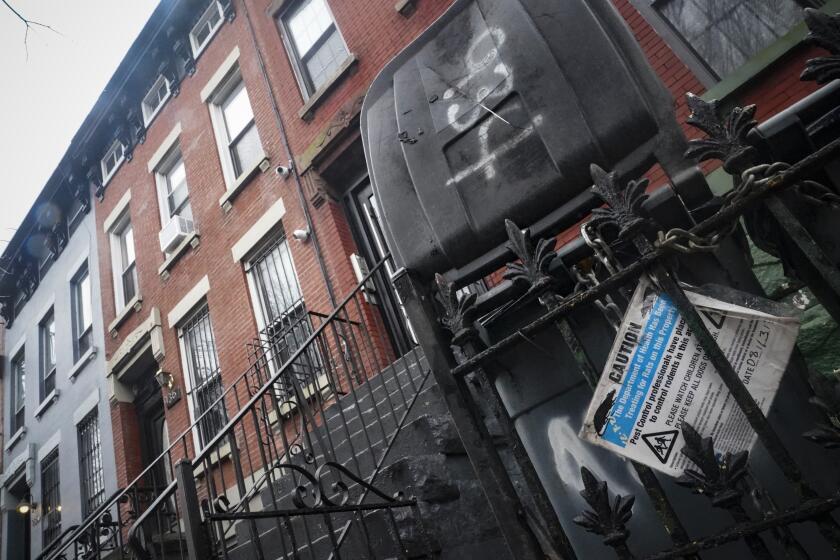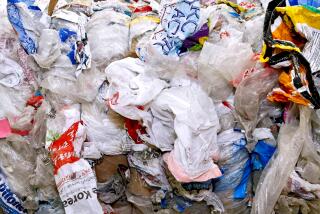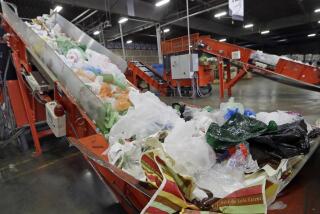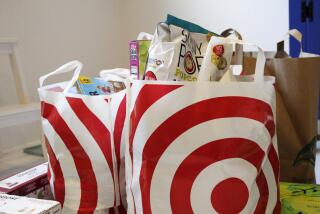New York puts tons of bagged trash on the curb daily. The city has a plan to contain the mess

- Share via
- For half a century, New York City residents have taken out their trash by flinging plastic bags stuffed with garbage straight onto the sidewalk.
- Now many are having to adjust to putting their garbage in bins on the street.
- “I know this must sound absurd to anyone listening to this who lives pretty much in any other city in the world,” said the city’s former sanitation commissioner.
NEW YORK — For half a century, New York City residents have taken out their trash by flinging plastic bags stuffed with stinking garbage straight onto the sidewalk.
When the bags inevitably leak or break open, they spill litter into the street, providing smorgasbords for rats. In the winter, the trash mounds get buried in snow and remain frozen in place for days, sometimes weeks, reinforcing the city’s reputation as dirty.
Now, New Yorkers are slowly adjusting to a radically new routine, at least for America’s biggest city: putting their trash in bins. With lids.
Covered bins became a requirement this month for all residential buildings with fewer than 10 living units. That’s the majority of residential properties. All city businesses had to start using bins earlier this year.
“I know this must sound absurd to anyone listening to this who lives pretty much in any other city in the world,” said Jessica Tisch, the city’s former sanitation commissioner, who oversaw the new measures before becoming the city’s new police commissioner this week. “But it is revolutionary by New York City’s standards because, for 50 years, we have placed all our trash directly on the curbs.”
The United Nations estimates that up to 10% of all human-produced greenhouse gases are generated by food loss and waste. That’s nearly five times the emissions from the aviation industry.
Residents who’ve already experienced trash containerization elsewhere agree New York City is long overdue to catch up.
“You see plastic bags open with the food just rotting and stinking and then it’s leaking out over the sidewalk and into the road,” said John Midgley, who owns a brownstone in Brooklyn and has lived in London, Paris and Amsterdam. “Just the stink of it builds up, you know, week after week after week.”
New York City’s homes, businesses and institutions put about 44 million pounds of waste out on the curb every day, about 24 million pounds of which is collected by the city’s sanitation department. Much of the rest is handled by private garbage carters.
In the early 20th century, New York City required trash to be placed in metal cans. But in the era before widespread plastic bag use, refuse was thrown directly into the bins, making them filthy and grimy.
Then in 1968, the city’s sanitation workers went on strike. For more than a week, trash cans overflowed. Garbage mounds piled high on sidewalks and spilled into the streets like some dystopian nightmare.
Plastic bag makers donated thousands of bags to help clean up the mess, and New Yorkers never looked back, said Steven Cohen, a Columbia University dean specializing in public affairs.
“It had to do with convenience,” he said. “After the strike, the sanitation workers preferred the modern advance of lighter and seemingly cleaner sealed plastic bags.”
Plastic kept more odors in, compared with the old metal bins. A worker could grab the neck of a bag and easily fling it into a truck.
New York City Mayor Eric Adams is contesting tickets from his own health department over rodents allegedly taking residence at his Brooklyn townhouse.
But Democratic Mayor Eric Adams’ administration has deemed trash bag mounds Public Enemy No. 1 in his well-documented war against the city’s notorious rats.
Rats have little problem getting into a plastic bag. Durable bins with closing, locking lids should, in theory, do a better job of keeping them out.
The bin requirement, which took effect Nov. 12, comes with its own challenges. Among them: finding a place for large, wheeled bins in neighborhoods where most buildings don’t have yards, alleys or garages. And landlords and homeowners have to collect the empty bins and bring them back from the curb — something you didn’t have to do with plastic bags.
Caitlin Leffel, who lives in Manhattan, said residents of her building had to hire someone “at surprisingly high cost” to bring out the bins the night before and bring them back in three times a week.
“I know there are problems with the way this city has collected trash for years,” she said. “But the way this program has been rolled out, it has not taken into account many of the nuances of living in New York City.”
Building superintendents are also grumbling about the added work of bringing bins back from the curb.
“It’s completely rearranged our lives,” says Dominick Romeo, founder of NYC Building Supers, a group of building managers that recently rallied in front of City Hall against the new requirements. “Folks are running around like crazy.”
Eventually, the largest residential buildings — those with more than 31 units — will have their own designated container on the street. New trash trucks built with automated, side-loading arms — another innovation that is already common in many other places — will then clear them out.
The upgrades should make pickups easier and cleaner, even if it might take longer for trash collectors to make the rounds, says Harry Nespoli, president of the union representing some 7,000 city sanitation workers.
For now, he says, workers are still tossing trash into their trucks manually, which has its own downsides.
“Some places, they’re not even using bags. They’re just putting their trash into the bins,” Nespoli said. “It’s going to take time to get everyone to do it the right way, but at the end of the day, it’s our job to pick it up.”
Tisch believes New Yorkers will eventually come around to the new reality.
City officials, for now, are issuing written warnings for noncompliance. Not everyone knows about the new rules yet. But come Jan. 2, fines ranging from $50 to $200 will kick in.
“No one wants to live on a dirty block,” Tisch said. “No one wants to walk past a heaping mound of trash and trash juice when they are leaving to go to work or they are walking their kids home from school.”
Marcelo writes for the Associated Press.
More to Read
Sign up for Essential California
The most important California stories and recommendations in your inbox every morning.
You may occasionally receive promotional content from the Los Angeles Times.












